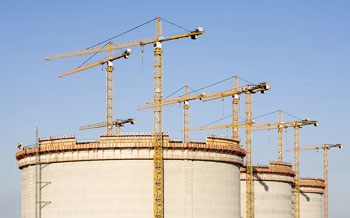Lithium-Ion Based Energy Storage Systems
 Lithium-Ion based energy storage systems have become increasingly important in recent years, and as a result much effort has been expended in describing and solving the fire protection concerns regarding these types of (battery) systems. The 2018 International Fire Code added Section 608, FM Global released DS 5-33 and the National Fire Protection Association proposed Standard 855 to address concerns arising from the storage and use of these systems. However, only limited test data are available on the fire hazards of energy storage systems.
Lithium-Ion based energy storage systems have become increasingly important in recent years, and as a result much effort has been expended in describing and solving the fire protection concerns regarding these types of (battery) systems. The 2018 International Fire Code added Section 608, FM Global released DS 5-33 and the National Fire Protection Association proposed Standard 855 to address concerns arising from the storage and use of these systems. However, only limited test data are available on the fire hazards of energy storage systems.
NFPA’s Research Foundation (FPRF) released a report [13] summarizing test results from small and intermediate scale free burn tests, as well as from large scale free burn and sprinklered testing (additional information on energy storage systems can be found in this article). These fire tests were performed in collaboration with FM Global.
FPRF’s technical report is available from NFPA’s website as a free download. FM Global’s technical report [14], which discusses these tests in greater detail is available from FM’s website.
Conclusion
The report [13] concluded that:
“Every test level showed for both (tested) battery chemistries that ignition of a single module was sufficient to involve all modules within the rack tested. Comparing the two battery types, all stages of testing showed the LFP (Li-Iron Phosphate, capacity of 120 Ah) modules presented a lower fire hazard risk than the NMC (Nickel Manganese Oxide Cobalt, capacity of 130 Ah) modules. During the LFP test, a single sprinkler operated and was able to control the fire spread to the origin (test) rack. In the NMC test, multiple sprinklers activated resulting in a demand area of over 2,500 ft2, and the fire spread from the origin rack to the target rack.”
|
|
Sprinklers are effective in delaying or preventing fire spreading to adjacent racks. |
|
|
Separation between ESS and other combustibles is essential to effective fire protection. |
|
|
Energy Storage Systems (ESS) comprised of LFP batteries under 15 ft ceilings was adequately protected by the target sprinkler protection. The water supply should be based on a minimum of 2,500 ft2 demand area with a duration of at least 90 minutes. The conclusions are based on a single sprinkler operation controlling the fire to the rack of origin with no involvement of the target rack. |
|
|
ESS comprised of NMC batteries under 15 ft ceilings can be adequately protected by the target sprinkler protection. However, excessive (amount of) ceiling sprinklers operated during the test conservatively representing a demand area > 2,500 ft2. In addition, fire spread from the origin rack to the adjacent target rack indicating that ESS racks installed side-by-side in a row could eventually be involved in the fire. |
|
|
Large-scale free burn tests as described in Section 6.1 of the FM Global report [1] are recommended to determine adequate space separation distances to prevent fire spread to nearby combustibles or damage to non-combustibles when sprinkler protection is not provided. Large-scale free burn testing is also necessary whenever there is doubt regarding the potential impact a change in an ESS design feature may have on the system hazard. |
|
|
Large-scale sprinklered tests as described in Section 6.2 of the FM Global report [1] are recommended to determine adequate space separation distances to prevent fire spread to nearby combustibles or damage to non-combustibles, as well as sprinkler protection design including discharge density/area and water supply duration |
Furthermore it has been highlighted that “… a fire watch should be present until all potentially damaged ESS equipment containing lithium-ion batteries is removed from the area following a fire event. Fires involving lithium-ion batteries are known to reignite. Lithium-ion batteries involved in fires should be adequately cooled in order to prevent reignition. This project has not addressed explosions hazards or any mitigation strategies that may be necessary during an ESS fire event, or firefighting efforts” and “… ESS fires will require lengthy hose stream water durations for final extinguishment. The geometry and installation arrangement of ESS’s will affect hose stream water demand and duration potentially beyond/exceeding traditional code requirements for hose streams.”
Finally general protection recommendations for lithium-ion battery based ESS are provided and which were developed through fire testing (discussed in this report and incl. recommendations provided by FM Global reports [1,6]).
References
[1] B. Ditch, D. Zeng, “Development of Sprinkler Protection Guidance for Lithium Ion based Energy Storage Systems” FM Global Technical Report March 2019.[2] J. Lamb, C. J. Orendorff, L. A. Steele, and S. W. Spangler, “Failure propagation in multi-cell lithium ion batteries,” Journal of Power Sources, vol. 283, pp. 517-523, June 2015. DOI: 10.1016/j.jpowsour.2014.10.081.
[3] H. Webster. (May, 2012, accessed 12-13-2018) Full Scale Battery Fire Test Plan Update. presentation. [Online]. https://www.fire.tc.faa.gov/pdf/systems/May12Meeting/Webster-0512-FullScaleBatteryTestPlanUpdate.pdf.
[4] A. Blum and R. T. Long, “Hazard Assessment of Lithium Ion Battery Storage Systems,” Final Report prepared for Fire Protection Research Foundation February, 2016.
[5] DNV-GL, “Considerations for ESS Fire Safety,” Consolidated Edison New York, NY, Final Report OAPUS301WIKO(PP151895), Rev. #, 2017.
[6] B. Ditch, “Development of Protection Recommendations for Li-ion Battery Bulk Storage: Sprinklered Fire Test,” FM Global, Technical Report 3053291, 2016.
[7] National Fire Protection Association Standard 13, Standard for the Installation of Sprinkler Systems, 2010.
[8] National Fire Protection Association Standard 855, Standard for the Installation of Stationary Energy Storage Systems, Proposed Standard, anticipate issuance in 2019.
[9] FM Global Property Loss Prevention Data Sheets 5-33, Electrical Energy Storage, January 2017.
[10] FM Global Property Loss Prevention Data Sheets 1-20, Protection Against Exterior Fire Exposure, Interim Revision, October 2016.
[11] National Fire Protection Association Standard 80A, Recommended Practice for Protection of Buildings from Exterior Fire Exposures, 2017.
[12] National Fire Protection Association Code 5000, Building Construction and Safety Code, 2018.
[13] R.Thomas Long, Jr., P.E., CFEI, Amy M. Misera, CFEI, “Sprinkler Protection Guidance for Lithium-Ion Based Energy Storage Systems”, National Fire Protection Association, Final Report, June 2019
[14] Benjamin Ditch, Dong Zeng, “Development of Sprinkler Protection Guidance for Lithium Ion Based Energy Storage Systems” FM Global, Norwood, MA, June 2019



